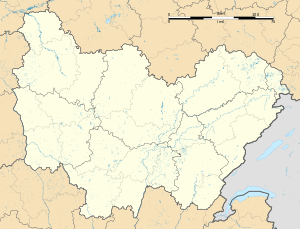Bligny-sur-Ouche
Bligny-sur-Ouche is a commune in the Côte-d'Or department in eastern France.
Bligny-sur-Ouche | |
|---|---|
 The church in Bligny-sur-Ouche | |
.svg.png) Coat of arms | |
Location of Bligny-sur-Ouche 
| |
 Bligny-sur-Ouche  Bligny-sur-Ouche | |
| Coordinates: 47°06′25″N 4°40′14″E | |
| Country | France |
| Region | Bourgogne-Franche-Comté |
| Department | Côte-d'Or |
| Arrondissement | Beaune |
| Canton | Arnay-le-Duc |
| Intercommunality | Canton de Bligny-sur-Ouche |
| Government | |
| • Mayor (2008–2014) | Michèle Barbier |
| Area 1 | 27.99 km2 (10.81 sq mi) |
| Population (2017-01-01)[1] | 831 |
| • Density | 30/km2 (77/sq mi) |
| Time zone | UTC+01:00 (CET) |
| • Summer (DST) | UTC+02:00 (CEST) |
| INSEE/Postal code | 21087 /21360 |
| Elevation | 337–549 m (1,106–1,801 ft) (avg. 363 m or 1,191 ft) |
| 1 French Land Register data, which excludes lakes, ponds, glaciers > 1 km2 (0.386 sq mi or 247 acres) and river estuaries. | |
The history of Bligny is ancient.
Its church is an interesting monument to visit (constructed within an old medieval castle) and is dedicated to Saint Germain l'Auxerrois.
The history of the rural community of Bligny is characterized by a specific political organisation to the extent it was under the dual jurisdiction of the Bishop of Autun and the Duke of Burgundy. As a result, it was self-organised from the medieval times and ruled by a local mayor (the position was kept in the same family Le Maire).
Since the 12th century, the village was protected by a regiment of archers which was constituted by all the valid men of the community (the regiment remained faithful to the Duke of Burgundy and was therefore dissolved).
To a certain extent, this regiment still remains through the existence of the Confrérie Saint Sébastien which is a Catholic organisation running charities and involved in the local parish and the local hospital (the Confrérie is composed of around 300 members and has a "batonnier"). The coat of arms of Bligny is an arch by reference to this regiment and the Confrérie de la Saint Sébastien.
The famous writer Michel Tournier has spent much time in Bligny in his childhood (his grandfather held a chemistry) and has written about Bligny-sur-Ouche and Lusigny-sur-Ouche in his book Le vent Paraclet translated in English as The Wind Spirit (his most unsuccessful book!). He notably narrates the intrusion of the Prussians in the 1870s (more anecdotical) and the Germans in the 1940s (notably the dramatic events which occurred in Lusigny at the end of the war).
The history of Bligny-sur-Ouche was written in the early 20th century (well-written and complete book). A few monographs were also published and even a detective story was published recently embarrassing all the various historical and geographical elements of Bligny. However, a real academic history of Bligny still needs to be written. All the references are published on the French version of the article Wikipedia.
Population
| Year | Pop. | ±% |
|---|---|---|
| 1781 | 180 | — |
| 1900 | 1,075 | +497.2% |
| 1962 | 749 | −30.3% |
| 1968 | 750 | +0.1% |
| 1975 | 719 | −4.1% |
| 1982 | 765 | +6.4% |
| 1990 | 745 | −2.6% |
| 1999 | 750 | +0.7% |
| 2008 | 847 | +12.9% |
See also
References
- "Populations légales 2017". INSEE. Retrieved 6 January 2020.
| Wikimedia Commons has media related to Bligny-sur-Ouche. |